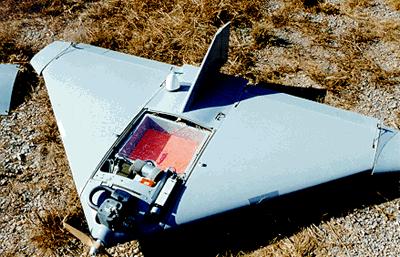
This little baby is only 2.6 metres long....
http://perso.wanadoo.fr/cacsystemes/drones_f.html
Use that to ID enemy concentrations, and then send in Marine
AH-1 Cobras to rocket and cannon the shit out of strongpoints
before you go inside the city..
 http://www.fas.org/irp/program/collect/dragon.htm
http://www.fas.org/irp/program/collect/dragon.htm
BQM-147A Exdrone
Dragon Drone
The Exdrone system is a low-cost reconnaissance unmanned aerial vehicle designed to support regiment and brigade size commands. It is a delta platform flying wing air vehicle that is 5 feet long and has a wingspan of 8 feet, powered by a small one-cylinder, two-cycle, air-cooled engine with a two-blade propeller. The flight control system consists of a UHF uplink receiver connected to a Global Positioning System (GPS) based autopilot. The autopilot is a 16-bit microprocessor controlled system which provides up to 5-pre-programmable waypoints. The air vehicle is gyro stabilized and capable of programmed autonomous flight. It uses microwave energy to downlink information to the ground control stations. When tasked, the Exdrone launches from a secure area behind the Forward Line of Own Troops (FLOT). It has a launch weight of 89 pounds and a 25 pound payload capacity. It is launched by a pneumatic rail. Once airborne, the launch pilot flies the air vehicle to the cruise altitude. The vehicle service ceiling is 10,000 feet, however, the mission altitude is usually between 3,000 - 4,000 feet above ground level. It has three modes of operation: Manual flight, manual override autopilot, or full autonomous. The Exdrone began as a research and development effort to build a low-cost expendable drone capable of carrying a VHF communications jammer. The aircraft have since been modified with several different payloads to provide reconnaissance. One of the payloads is the Pulinex TM-7i down-looking color TV camera. It is a commercial-off-the-shelf color camera that provides 570 lines of resolution and a six power zoom lens. This particular camera has a national imagery interpretability rating scale (NIRS) of 4 at 3,000-4,000 feet above ground level. Other payloads available include an Image Intensifier, and Forward Looking Infrared (FLIR) cameras. Experimentation and testing continue for additional payloads. These payloads include a communication jammer, communications relay, deception decoys, mine detection capabilities, and an airborne nuclear, biological and chemical detection suite. Most of these payloads are commercial-off-the-shelf or government-off-the- shelf technologies. An Exdrone unit consists of ten air vehicles, two ground control stations, a pneumatic launcher, associated ground support equipment, and crew of six people. The system is small enough to be transported over land in two High Mobility Multipurpose Wheeled Vehicles (HMMWV), or flown into the theater of operations by one C-130 cargo aircraft. The 101st Airborne and 1st Cavalry Divisions currently operate the system. Once the vehicle is launched and reaches cruise altitude, the launch pilot activates the autopilot which takes control and proceeds to the mission target area. The aircraft has a top speed of 100 miles per hour and a mission endurance of about two-and-a-half hours. The vehicle is controlled by the launch team if the operating area is within line-of-sight of the ground control station (usually about 50 kilometers). To extend operational range, a forward control team equipped with a Ground Control System can be positioned closer to the objective and extend the range. The Exdrone can loiter for about two hours. After reaching the target area the autopilot is programmed to loiter, fly a fixed track of way points, conduct point reconnaissance with the forward control pilot directing the flight, or conduct point reconnaissance with the launch pilot in control. When the mission is complete the autopilot guides the aircraft to a predetermined recovery point where it is recovered by parachute. If more coverage time is needed, another vehicle is launched and sent to the objective before returning the first aircraft. The Ground Control System can control two aircraft simultaneously. The Exdrone has several limitations. First it has a short range because it is restricted by line-of-sight controls. Measures are needed to increase its range. Second, the UHF uplink control frequency band is often used for tactical communications. If proper frequency coordination is not made, the Exdrone can be jammed by friendly forces. If "friendly" forces can jam it unintentionally, it seems obvious that "unfriendly" forces could intentionally jam it. Finally, the aircraft has a very small payload, putting severe limitations on the amount of equipment and sensors that can be mounted on a single aircraft.
The Dragon Drone originated as the Exdrone and flew successful missions during Advanced Warfighting Experiment Hunter Warrior at 29 Palms, California. The drone was originally designed to provide a small, inexpensive, but highly capable sensor delivery asset at the lower unit level. However, the Dragon Drone exceeded its original design. Marines with no UAV experience conducted missions. The drone provided near-real-time video surveillance of the battlefield to the ECOC at Camp Pendleton.
Additional capabilities include: night FLIR image transmission with laser rangefinder, day color image transmission with laser rangefinder, target identification and location to within 50 meters, non-lethal weapons delivery, and surveillance for search and rescue operations.
Currently, 10 Dragon Drones are assigned to each of the following commands: I Marine Expeditionary Force, Camp Pendleton, Calif.; II Marine Expeditionary Force, Camp Lejeune, NC; Marine Expeditionary Force replacements; and the Marine Corps Warfighting Lab for further technology development.
The Marine Corps Warfighting Laboratory (MCWL) has a requirement to purchase Reconnaissance / Surveillance And Target Acquisition (RSTA) payloads for the Dragon Warrior program. Dragon Warrior is an experimental Vertical Take Off and Landing (VTOL) drone currently in development under contract number M67854-99-C-2081. In previous years, MCWL has purchase 21 payloads consisting of day Pan, Tilt, Zoom (PTZ) cameras coupled with laser range finders and 14 pan-tilt Forward Looking Infrared (FLIR) cameras coupled with laser range finders. This requirement includes the fabrication and testing of Dragon Warrior RSTA payloads utilizing existing Government Furnished Equipment (GFE), if a cost savings is possible. Compared to the Dragon Drone payloads, the Dragon Warrior payloads shall be different in the following ways:



